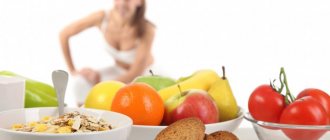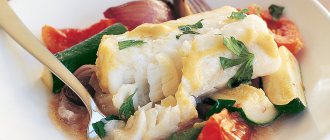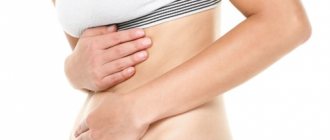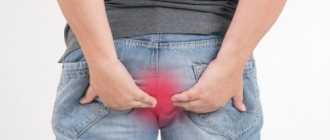General rules
It is known that colorectal cancer does not spread quickly. The tumor first grows around the circumference of the intestine, and subsequently grows into the entire wall, pelvic tissue and neighboring organs. And some time passes before the disease begins to manifest itself. In advanced cases, metastases in the lungs, liver and lymph nodes.
The causes of this disease are:
- Rectal polyps and long-term inflammatory diseases. With inflammation, which is constantly maintained, there are all conditions for the degeneration of intestinal epithelial cells. Any neoplasm, even benign, creates a risk of cancer.
- Dietary features: predominance of meat, animal fats, simple carbohydrates in food with a low content of plant fiber. Constipation that occurs against this background leads to the fact that the mucous membrane is constantly exposed to protein decay products, which have a carcinogenic effect, and high-calorie and easily digestible foods, which are simple carbohydrates, slow down the progress of the contents.
- Anal sex and human papillomavirus infection .
- Heredity.
The main method of treatment is resection of the tumor with part of the intestine or completely - this depends on the stage of the disease and the location of the tumor. If possible, only part of the intestine is removed along with the tumor, and its integrity is restored. Otherwise, when it is not possible to sew the ends of the intestine, after removing the tumor, the upper end is brought out onto the skin of the abdomen, forming a colostomy , which serves as an anus, and the lower end of the intestine is sutured. Subsequently, you can do a second operation and restore the integrity of the intestine. Treatment plans include radiation therapy (often combined with chemotherapy ) before or after surgery. Using radiation therapy before surgery can shrink the tumor and avoid a colostomy. Chemotherapy administered after surgery improves treatment results (reduces the risk of relapse).
During the long recovery period, along with ongoing treatment, diet therapy plays an important role. A diet for rectal cancer is aimed at preventing relapses of the disease and will allow the body to recover in a shorter time after surgery and chemotherapy, which negatively affects the metabolism in the body. An abandoned colostomy causes difficulties to a certain extent, since the patient needs to carefully monitor his diet and learn to control bowel movements. After surgery, patients need to follow a step-by-step diet, gradually expanding it and monitoring the intestinal reaction.
The diet after surgery for the first time should be as gentle as possible and not cause diarrhea or bloating. After resection, food intake begins with rice water, low-fat broth, and berry jelly without fruit. After a few days the following are allowed:
- Slimy soups (this is a strained decoction of cereals).
- Liquid, well-mashed porridge, boiled in water. Preference is given to non-coarse grains such as rice, oatmeal, and buckwheat.
- Cream (only in dishes up to 50 ml).
- Broths with semolina.
- Soft-boiled egg and egg white omelette.
- A little later, fish and meat puree is introduced.
Then, for the first six months after removal of the rectal tumor, nutrition is organized within Table No. 4B . The diet also ensures sparing of the gastrointestinal tract, since dishes are prepared pureed.
- Food should be fresh and easily digestible.
- Overeating is unacceptable; you need to eat 5-6 times in small portions. It is important to chew food thoroughly for better processing by saliva and further digestion.
- It is important to drink enough fluids to prevent constipation.
- It is necessary to limit meat consumption, focusing on fermented milk products. Preference is given to “live” kefir and yogurt (preferably homemade), which help normalize the microflora. Normally functioning microflora has an anticarcinogenic effect.
- You can consume dietary meat to a limited extent, but mainly fish (steamed cutlets, soufflé, quenelles, lump fish).
- Mashed porridges are allowed (millet, barley, pearl barley, and corn are excluded). They are prepared with water, broth and, if tolerated, with the addition of milk.
- Vegetables - boiled and pureed, steamed vegetable cutlets.
- Soups are prepared in a weak broth, mainly cereals and vegetables. Cereals in soups are pureed (can be kneaded well), and vegetables (potatoes, zucchini, carrots and cauliflower) are finely chopped. You can add meatballs, minced meat, and egg flakes.
- Wheat bread (dried) is recommended.
- Milk, sour cream and cream are added only to dishes, and fermented milk products can be drunk unlimitedly throughout the day. Low-fat pureed cottage cheese is allowed.
- You can drink rosehip infusion, weak tea, coffee with milk, juices diluted with water (apple, cherry, tangerine, strawberry, orange).
Excluded:
- Rich fatty broths.
- The first months - legumes, rye bread, coarse vegetables, wholemeal bread, any fresh bread, constantly - kvass, butter dough.
- Garlic, radish, radish, celery, spinach, onion.
- Milk in its natural form.
- Fatty meat, fish and poultry, canned meat and fish, smoked meats, hot sauces, pepper, mustard, horseradish.
- Coarse cereals - millet, pearl barley, barley, corn.
- Cooking fat, margarine, pork and beef fat, vegetable oil.
- Chocolate, carbonated drinks, cakes, ice cream, grape, plum and apricot juice, kvass.
Nutrition after surgery expands after six months and non-pureed food is recommended. In the later stages, the diet should be high in fiber (in the absence of diarrhea) through the consumption of cereals, bran bread, vegetables and fruits and a minimum content of animal fats. have noted a decrease in the incidence of disease when using a diet rich in fiber and vitamins A , E and C. A number of studies have shown the anti-carcinogenic effect of linoleic acid (it is found in animal and poultry meat, milk, cottage cheese, cheeses, cottonseed, coconut, palm, soybean, flaxseed, rapeseed oils, and somewhat less so in olive and sunflower oils).
Mandatory components of the diet are vegetables and fruits. An increased amount of fiber activates peristalsis and promotes the free passage of feces. In addition, almost all plant foods are cancer protective.
All green vegetables, as well as dandelion leaves, blue algae, chlorella, nettle leaves, and mustard greens contain large amounts of chlorophyll, which increases the body's resistance.
Vegetables and fruits that are orange and red-orange in color contain carotenoids ( beta-carotene and lycopene ) that have anti-cancer properties. These are tomatoes, pumpkins, carrots, yellow zucchini, oranges, grapefruits, tangerines, lemons, peaches and apricots.
Red and purple fruits and vegetables contain high levels of anthocyanidins , which are antioxidants and increase resistance to carcinogens . These plant foods are beets, blackberries, blueberries, cherries, red grapes, and red cabbage.
Cruciferous vegetables (broccoli, cabbage, Brussels sprouts and cauliflower, mustard greens, radishes and turnips) contain indole , which enhances the detoxifying effect of the liver and binds carcinogens. Restrictions apply to turnips and radishes if these vegetables are poorly tolerated by patients (increase bloating and pain in the intestines). Garlic and pineapples are also known for their anti-tumor properties.
Meat, even dietary varieties, should be consumed with caution, especially karse, giving preference to fish and seafood. Since trans fats stimulate tumor growth, animal fats should be excluded from the diet, and vegetable oils should be replaced by animal fats.
Unrefined vegetable oils contain vitamin E , an antioxidant that should be present in the diet of sick and healthy people. The two forms of vitamin E (delta and gamma tocopherols) found in nuts, soybean oil, corn oil and canola oil have been shown to prevent colorectal cancer. It is also found in all nuts (patients should not eat peanuts, since they are a rough nut and cause pain in the intestines), soybeans, dried apricots, sea buckthorn, oatmeal and buckwheat, carrots, pears, bananas, and cottage cheese.
The diet must necessarily include foods rich in selenium, which have an antitumor effect. It is found in products that are shown in descending order of its content: turkey liver, duck liver, chicken liver, pork liver, beef liver, octopus liver, eggs, corn, dark rice, beans, barley, lentils, pistachios, wheat, sprouted wheat grains, peas, peanuts, walnuts, broccoli, tomatoes, garlic, seeds, dried fruits. During heat treatment, the amount of microelement decreases. Green tea removes toxins and free radicals, so it can be recommended for patients.
The basic rules of nutrition during this period remain:
- Boiled and steam cooking methods, as well as baking are allowed.
- Chopped or unchopped meat and fish dishes, chopped boiled vegetables.
- Products that enhance fermentation (carbonated drinks, kvass), bananas and grapes are still excluded - as tolerated.
- Stimulants of gastric secretion (sorrel, mushrooms, radish, radish, horseradish, turnip, mustard, celery) are prohibited.
These are general nutritional recommendations and each new product must be introduced carefully and the patient must monitor his reaction. If a large amount of fiber increases bloating and causes excessive motility (frequent bowel movements from the colostomy), then the amount of vegetables is reduced or they are consumed in stewed form. Perhaps such a reaction will occur to one particular vegetable or fruit, then it is excluded from the diet. If milk is poorly tolerated, its consumption should be avoided forever. This does not apply to the consumption of fermented milk products - they are usually well tolerated and beneficial.
When should you not eat chicken broth?
No matter how high the benefits of this dish may be, there are nevertheless cases when it is better for people to refuse chicken broth in their diet:
- low acidity;
- liver diseases;
- allergy to chicken meat;
- pancreatitis;
- peptic ulcer;
- alcohol poisoning.
It is not advisable to give broth to small children. It is difficult to say exactly at what age they can use it, so it is better to first consult with your doctor about this.
In other cases (but only with the doctor’s permission), you really need to drink chicken broth after surgery. We described the recipe for a therapeutic diet step by step above, so use it and never get sick.
There are a huge number of reasons for carrying out such a radical form of treatment. And the same question - nutrition after intestinal surgery - faces all patients.
Authorized Products
- All vegetables and fruits consumed should not contain nitrates, which are a carcinogenic factor. The diet can include (as tolerated): lettuce, cauliflower, broccoli, cucumbers, eggplant, potatoes, tomatoes, carrots, zucchini, pumpkin, beets, lettuce, ginger, legumes, Jerusalem artichoke, garlic (in reasonable quantities), greens in soups. Vegetables are first consumed boiled and chopped, and gradually raw ones are included.
- Fruits and berries: watermelon, apples, avocados, dates, kiwi, raspberries, grapefruits, oranges, tangerines, strawberries, currants. Fruits are allowed to be consumed when they are ripe, first without the peel, and later, if well tolerated, with the peel. The amount of raw fruits and berries is increased to 200 g or more per day.
- Whole grain bread, bran bread, bran, flax seed, nuts, seeds, apricot kernels.
- Dietary meat (chicken and turkey - limited) in the form of cutlets or pieces - steamed or boiled, baking is allowed. However, preference is given to fish and seafood, since these proteins are easier to digest and absorb. Seaweed should be included in your diet every day.
- Beef liver and poultry liver.
- Soups with a weak broth, preferably vegetable. They should contain well-cooked cereals and finely chopped vegetables.
- Crumbly porridges are introduced (millet and pearl barley are excluded). Preference is given to brown rice (be careful, it can cause constipation) and buckwheat. They can be cooked in water, weak broth or with milk (cream). You can make pancakes, puddings, and casseroles from cereals.
- Fermented milk products and freshly prepared cottage cheese - daily, and milk and sour cream as an additive to dishes.
- A variety of unrefined vegetable oils (carefully taking into account the laxative effect).
- One or two eggs a day (omelet and soft-boiled).
- You can drink green tea, freshly squeezed juices diluted with water (add carefully, exclude beetroot, cabbage and grape).
Table of permitted products
| Proteins, g | Fats, g | Carbohydrates, g | Calories, kcal | |
Vegetables and greens | ||||
| vegetables legumes | 9,1 | 1,6 | 27,0 | 168 |
| zucchini | 0,6 | 0,3 | 4,6 | 24 |
| broccoli | 3,0 | 0,4 | 5,2 | 28 |
| cauliflower | 2,5 | 0,3 | 5,4 | 30 |
| potato | 2,0 | 0,4 | 18,1 | 80 |
| carrot | 1,3 | 0,1 | 6,9 | 32 |
| cucumbers | 0,8 | 0,1 | 2,8 | 15 |
| parsley | 3,7 | 0,4 | 7,6 | 47 |
| beet | 1,5 | 0,1 | 8,8 | 40 |
| dill | 2,5 | 0,5 | 6,3 | 38 |
| green beans | 2,8 | 0,4 | 8,4 | 47 |
Fruits | ||||
| oranges | 0,9 | 0,2 | 8,1 | 36 |
| pears | 0,4 | 0,3 | 10,9 | 42 |
| tangerines | 0,8 | 0,2 | 7,5 | 33 |
| apples | 0,4 | 0,4 | 9,8 | 47 |
Nuts and dried fruits | ||||
| dried pears | 2,3 | 0,6 | 62,6 | 249 |
Cereals and porridges | ||||
| buckwheat (kernel) | 12,6 | 3,3 | 62,1 | 313 |
| semolina | 10,3 | 1,0 | 73,3 | 328 |
| oat groats | 12,3 | 6,1 | 59,5 | 342 |
| cereals | 11,9 | 7,2 | 69,3 | 366 |
| Wheat groats | 11,5 | 1,3 | 62,0 | 316 |
| wheat bran | 15,1 | 3,8 | 53,6 | 296 |
| brown rice | 7,4 | 1,8 | 72,9 | 337 |
| brown rice | 6,3 | 4,4 | 65,1 | 331 |
| barley grits | 10,4 | 1,3 | 66,3 | 324 |
Bakery products | ||||
| vysivkovy bread | 9,0 | 2,2 | 36,0 | 217 |
| Old Russian grain bread | 9,6 | 2,7 | 47,1 | 252 |
| Rye bread | 6,6 | 1,2 | 34,2 | 165 |
| doctor's bread | 8,2 | 2,6 | 46,3 | 242 |
| whole grain bread | 10,1 | 2,3 | 57,1 | 295 |
Dairy | ||||
| skim milk | 2,0 | 0,1 | 4,8 | 31 |
| sour cream | 2,8 | 20,0 | 3,2 | 206 |
| acidophilus | 2,8 | 3,2 | 3,8 | 57 |
Cheeses and cottage cheese | ||||
| cheese | 24,1 | 29,5 | 0,3 | 363 |
| cottage cheese | 17,2 | 5,0 | 1,8 | 121 |
Meat products | ||||
| boiled beef | 25,8 | 16,8 | 0,0 | 254 |
| boiled veal | 30,7 | 0,9 | 0,0 | 131 |
| rabbit | 21,0 | 8,0 | 0,0 | 156 |
Bird | ||||
| boiled chicken | 25,2 | 7,4 | 0,0 | 170 |
| turkey | 19,2 | 0,7 | 0,0 | 84 |
Fish and seafood | ||||
| Red caviar | 32,0 | 15,0 | 0,0 | 263 |
| black caviar | 28,0 | 9,7 | 0,0 | 203 |
Oils and fats | ||||
| vegetable oil | 0,0 | 99,0 | 0,0 | 899 |
| butter | 0,5 | 82,5 | 0,8 | 748 |
Non-alcoholic drinks | ||||
| mineral water | 0,0 | 0,0 | 0,0 | — |
| green tea | 0,0 | 0,0 | 0,0 | — |
Juices and compotes | ||||
| Orange juice | 0,9 | 0,2 | 8,1 | 36 |
| Cherry juice | 0,7 | 0,0 | 10,2 | 47 |
| Strawberry juice | 0,6 | 0,4 | 7,0 | 31 |
| tangerine juice | 0,8 | 0,3 | 8,1 | 36 |
| carrot juice | 1,1 | 0,1 | 6,4 | 28 |
| tomato juice | 1,1 | 0,2 | 3,8 | 21 |
| pumpkin juice | 0,0 | 0,0 | 9,0 | 38 |
| Apple juice | 0,4 | 0,4 | 9,8 | 42 |
| * data is per 100 g of product | ||||
Recipes after intestinal surgery
Unfortunately, not many housewives know how to cook it. And it doesn't sound tasty, but after preparing this recipe, you will become a fan of this dish. Pour 2-3 tablespoons of oatmeal into boiling water (1 liter). Cook until the flakes are completely dissolved, about 1 hour. Then we strain, but do not wipe.
In the first period after the operation, add a little salt and eat. In the second period after surgery, you can add an egg-milk mixture. And in the third period, you can add some potatoes, grated carrots and boil again. Next, rub through a sieve - and a more delicious slimy soup is ready.
Meat or fish soufflé
For cooking you need 100 grams of minced meat. In our case, it should be minced meat or fish. One chicken egg yolk, 20-30 ml of milk and a teaspoon of semolina. Mix everything, add egg white.
Place the resulting mixture on a baking sheet and bake in the oven for 15-30 minutes until cooked. You can also cook in a double boiler.
Bon appetit and speedy recovery!
In the postoperative period, the patient is often prescribed a diet of pure chicken broth. And there are good reasons for this: recovery from serious illnesses and operations requires maximum concentration of vital forces from the body, and, therefore, a special approach to nutrition.
The healing properties of chicken broth are widely known in the medical community. Experts believe that it is ideal for restoring the body, weakened by both severe operations and common colds.
There are some rules for preparing broth for a sick person, which allow you to preserve the nutrients in the broth as much as possible and avoid side effects.
Fully or partially limited products
- Non-perishable products with chemical additives.
- Animal fats, margarine, cooking fats, butter, mayonnaise.
- Fried food.
- Products made from refined flour, baked goods, pastries, cakes.
- Products with chemical stabilizers, emulsifiers, dyes and sweeteners, which are highly oncogenic substances.
- Fatty meats and red meats.
- All canned food, sauces, marinades, pickles, smoked meats and sausages, since these products contain dyes, stabilizers and promote the growth of tumor cells.
- Strong coffee, tea, chocolate. Avoid the consumption of sugar and simple carbohydrates, which stimulate the growth of cancer cells and accelerate the process of metastasis.
Table of prohibited products
| Proteins, g | Fats, g | Carbohydrates, g | Calories, kcal | |
Vegetables and greens | ||||
| swede | 1,2 | 0,1 | 7,7 | 37 |
| parsnip | 1,4 | 0,5 | 9,2 | 47 |
| parsley (root) | 1,5 | 0,6 | 10,1 | 49 |
| radish | 1,2 | 0,1 | 3,4 | 19 |
| white radish | 1,4 | 0,0 | 4,1 | 21 |
| turnip | 1,5 | 0,1 | 6,2 | 30 |
| celery | 0,9 | 0,1 | 2,1 | 12 |
| horseradish | 3,2 | 0,4 | 10,5 | 56 |
| garlic | 6,5 | 0,5 | 29,9 | 143 |
| spinach | 2,9 | 0,3 | 2,0 | 22 |
| sorrel | 1,5 | 0,3 | 2,9 | 19 |
Fruits | ||||
| bananas | 1,5 | 0,2 | 21,8 | 95 |
| melon | 0,6 | 0,3 | 7,4 | 33 |
Berries | ||||
| grape | 0,6 | 0,2 | 16,8 | 65 |
Mushrooms | ||||
| mushrooms | 3,5 | 2,0 | 2,5 | 30 |
Nuts and dried fruits | ||||
| dried fruits | 2,3 | 0,6 | 68,2 | 286 |
Cereals and porridges | ||||
| pearl barley | 9,3 | 1,1 | 73,7 | 320 |
| millet cereal | 11,5 | 3,3 | 69,3 | 348 |
Flour and pasta | ||||
| pasta | 10,4 | 1,1 | 69,7 | 337 |
| noodles | 12,0 | 3,7 | 60,1 | 322 |
Confectionery | ||||
| candies | 4,3 | 19,8 | 67,5 | 453 |
| pastry cream | 0,2 | 26,0 | 16,5 | 300 |
| Kurabye cookies | 6,7 | 25,8 | 64,6 | 516 |
| butter cookies | 10,4 | 5,2 | 76,8 | 458 |
Ice cream | ||||
| ice cream | 3,7 | 6,9 | 22,1 | 189 |
Cakes | ||||
| cake | 4,4 | 23,4 | 45,2 | 407 |
Raw materials and seasonings | ||||
| seasonings | 7,0 | 1,9 | 26,0 | 149 |
| mustard | 5,7 | 6,4 | 22,0 | 162 |
Meat products | ||||
| pork | 16,0 | 21,6 | 0,0 | 259 |
Sausages | ||||
| dry-cured sausage | 24,1 | 38,3 | 1,0 | 455 |
Bird | ||||
| duck | 16,5 | 61,2 | 0,0 | 346 |
| goose | 16,1 | 33,3 | 0,0 | 364 |
Fish and seafood | ||||
| dried fish | 17,5 | 4,6 | 0,0 | 139 |
| smoked fish | 26,8 | 9,9 | 0,0 | 196 |
| canned fish | 17,5 | 2,0 | 0,0 | 88 |
Oils and fats | ||||
| animal fat | 0,0 | 99,7 | 0,0 | 897 |
| cooking fat | 0,0 | 99,7 | 0,0 | 897 |
Non-alcoholic drinks | ||||
| bread kvass | 0,2 | 0,0 | 5,2 | 27 |
Juices and compotes | ||||
| apricot juice | 0,9 | 0,1 | 9,0 | 38 |
| grape juice | 0,3 | 0,0 | 14,0 | 54 |
| plum juice | 0,8 | 0,0 | 9,6 | 39 |
| * data is per 100 g of product | ||||
Harmful factors
Despite the beneficial properties that poultry meat broth has, if chosen and prepared incorrectly, it can cause significant harm to a weakened body.
The recipe for preparing broth for seriously ill patients or in the first days after surgery should exclude salt and vegetables. For all convalescents, spices and any ingredients that can irritate the gastric mucosa are excluded.
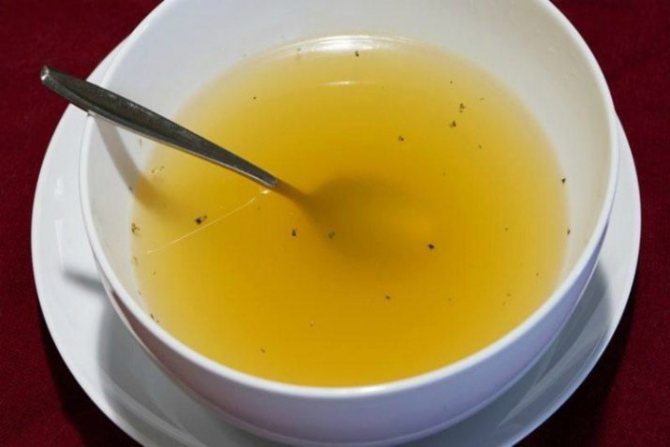
In case of alcohol poisoning, broth is indicated only after intoxication has been removed, that is, to restore strength. Rinse the body of toxins and restore the water-salt balance only with clean boiled water.
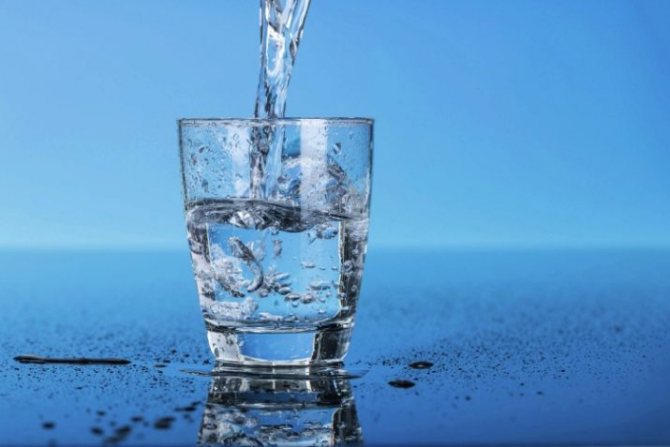
Factory-bred chickens are chemically stimulated to promote rapid growth, as well as given antibiotic injections to prevent disease. In this case, all chemical components will end up in the broth if you cook the meat in the usual way.
Menu (Power Mode)
The diet should consist of 2/3 plant products and 1/3 animal products. It can be made varied by including different vegetables, cereals and dishes made from them. Usually for breakfast - any porridge and an egg. Try to eat porridge every day with the addition of seeds (pumpkin, sunflower, sesame, flax), raisins, dried apricots, and nuts.
The second breakfast can consist of cottage cheese with dried fruits or fresh fruits (berries). For lunch - any cereal or vegetable soups. If at first it is not possible to introduce raw vegetables due to bloating, discomfort or weakness, they can be replaced with boiled or baked ones. And over time, you can make salads from fresh vegetables by adding seaweed. Legumes contain a large amount of fiber and vegetable protein, and if tolerated, try to eat them every other day.
Fish and fish dishes are easier to tolerate for patients, so it is better to include them in the diet every day. Vegetable oils are added to prepared dishes. Try to alternate them and not use them for heat treatment. Change your diet, make it healthy by eliminating chocolate, pastries and confectionery, and instead eat nuts, fruits, dried fruits for snacks and dessert.
Second period
If the postoperative period progresses well, the patient is transferred to the general ward on days 3-4. The diet after intestinal surgery should still be gentle on the intestines. But it is already more varied, and a gradual load on the intestines with more solid food begins.
The following cereals are allowed: wheat, rye, oatmeal, rice, semolina. You can use them to prepare slimy porridges using water. You can also make slimy soups using meat broth with these cereals. Diversify the menu with fish and meat souffles, steamed protein omelettes. You can also enjoy sweet mousses and low-fat dairy products.
Reviews and results
This therapeutic diet is balanced, which allows you to stick to it constantly. The restrictions apply only to products related to unhealthy diets (fatty, fried foods, smoked foods, canned food, sweets, foods with preservatives). After surgery, everyone tries to monitor their diet more carefully and considers it easy and healthy for everyone, especially in old age.
- “... I had surgery, of course - it’s a scary thing to go through! But we must continue to live and hope, and also follow all the recommendations. I followed the diet strictly, and then I began to introduce more vegetables and discomfort appeared and I became weaker. I switched back to stewed vegetables. On the second attempt, I was able to identify vegetables that suit me raw; I grate them on a fine grater or chop them finely. I have been living the life of a healthy person for three years now (of course, I get examined every six months). Sometimes my stomach swells, but this happens from fresh vegetables and beans and lentils. Despite the fact that they are healthy, I can only eat them once a week. I tolerate all other products well”;
- “... My dad had part of his intestine removed and now has an ostomy. He lives normally with her and has adapted, so no one knows about it except those close to him. Now there are so many products to care for her that you can live comfortably. The doctor warned about the need to follow a diet. True, at first it was difficult to adapt and regulate nutrition - sometimes loose stools, sometimes hardening. And then everything returned to normal, he was helped by yogurt (we make it ourselves) and bifidobacteria, which he drank for 3 months”;
- “... I lived with a colostomy for six months after the tumor was removed, and then there was a repeat operation. I am constantly on a diet and try to stick to a separate diet, which includes rice, buckwheat, fish, white chicken breast, omelet, cottage cheese, kefir, herbal teas, honey. I tried different foods, including vegetables, but the intestines do not accept the rest - bloating and pain immediately appear. I drink a lot of water - 2.5 liters. With proper nutrition there are no problems with the intestines. I think that everyone can find suitable and well-tolerated products for themselves and everything will be fine.”
How to properly make chicken broth for a patient after surgery
There are no particular differences in preparing broth for a sick person from preparing regular broth. In general everything is the same. However, there are some nuances in preparing postoperative broth that should be taken into account so as not to harm your loved one.
Rule #1: Choosing chicken meat
The richness of it will depend on what part of the carcass you use for the broth. For example, chicken wings and legs, as well as other parts of it, which contain quite a lot of dark meat and bones, will make a very rich broth. Because it contains a lot of fat, it is not suitable for people recovering from surgery.
A medium-fat broth can be obtained by cooking in a soup set (it mainly includes cartilage, back, wings and neck). A good broth is made from half or a whole bird carcass. But especially for the postoperative period, a dish made from breast is suitable, since it turns out to be especially light and light.
Rule No. 2: Drain the first water from the chicken
Not everyone has the opportunity to purchase poultry from a trusted person (although this would be ideal). Most of us buy meat in stores or supermarkets, where it comes from large poultry farms. They raise broiler chickens there, which are specially fed so that they grow quickly, and they are also fed antibiotics so that they do not get sick.
And since during cooking the meat gives up most of it to water, all these harmful substances will end up in the broth. Such a remedy will definitely do more harm than good, so drain the first water 10 minutes after boiling (when foam has already appeared).
Next, wash the chicken, put it in a clean pan, add a fresh portion of water and put it on the fire. Only now can you prepare a real healing broth.
Rule #3: How long to cook chicken broth
If you are using store-bought poultry, 1-1.5 hours will be enough. Country poultry takes longer to cook - about 2-3 hours. If the chicken is young, then it will cook in 2 hours; a more mature carcass will cook in about 3 hours.
How to cook?
The main rule of cooking chicken broth for a person who has suffered from an illness is that the broth should not be fatty. To do this, fat and skin must be removed from the chicken carcass, and for people with gastrointestinal problems, only chicken breast and, as a last resort, wings are taken.
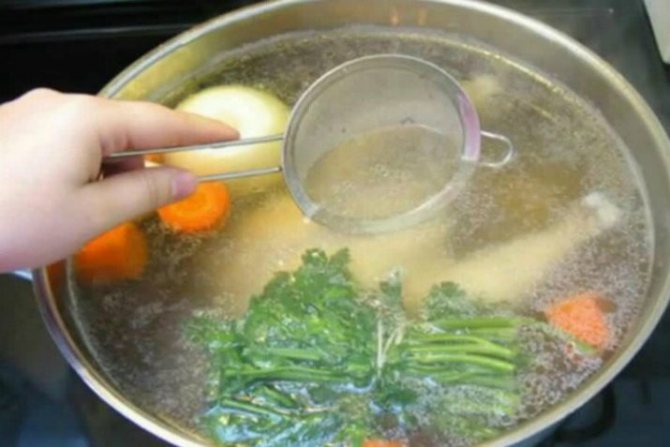
In the first days, the convalescent is given lightly salted broth without vegetables. For patients who have undergone abdominal surgery, it is very important to prepare a second boil broth. To do this, you need to let the chicken simmer for 10 minutes, then drain the first broth and refill the pan with clean cold water. During cooking, be sure to skim off the foam and keep the pan over medium-low heat to avoid excessive bubbling. This will make the broth clean and clear.
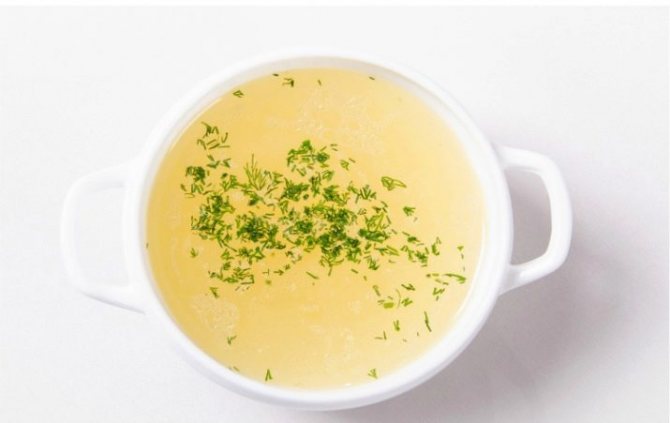
Proper preparation of healthy broth for a patient involves several steps.
- Wash the chicken thoroughly and gut it. Remove entrails, skin and subcutaneous fat. For a rich broth, boil a whole chicken or its individual parts. In this case, the breast can be left for the following days, when the convalescent diet allows you to take ground white meat.
- The pieces are placed in a pan and filled with clean cold water so that the meat is covered by a few centimeters. Bring to a boil over high heat and cook for 10 minutes, then drain the first broth, add a new portion of water and bring to a boil again. After boiling, cook over low heat for one and a half to two hours.
- During the cooking process, the foam is removed, and the finished broth is filtered through cheesecloth or a sieve.
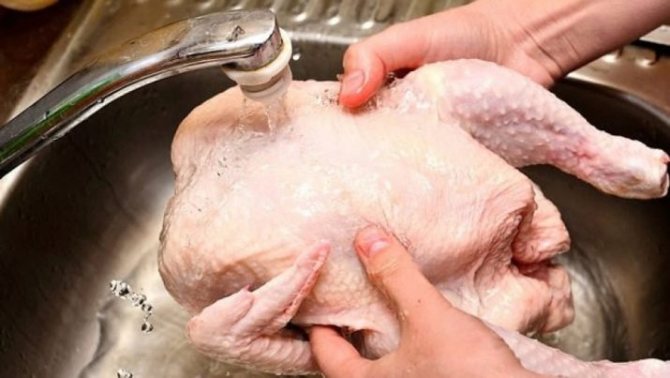
In subsequent days, when cooking the broth, you can add the whole onion and remove it when straining. The onion will saturate the broth with vitamins, and if you leave the bottom layer of husk, the broth will acquire a golden “delicious” hue. This may be important for patients who have no appetite at all.
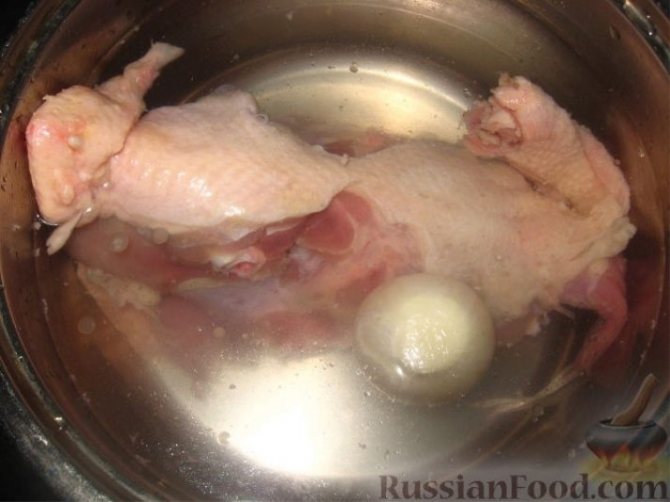
As you recover, carrots and potatoes are added to the chicken broth; white bread croutons and hard-boiled eggs (chicken or quail) are served with the dish. Quail eggs are preferable, as they contain a large number of useful microelements.
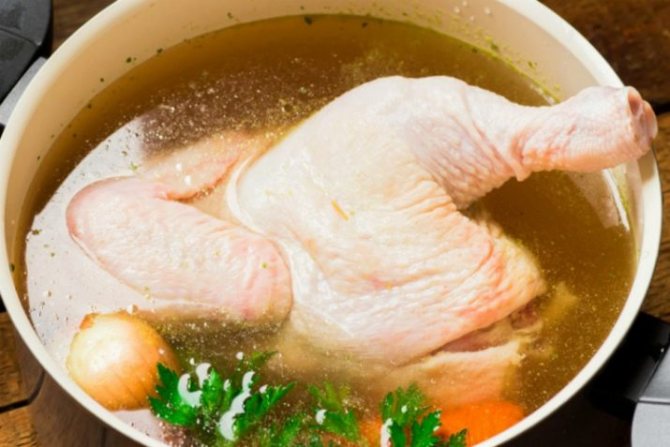
The transparent broth, decorated with a slice of boiled egg and pieces of bright carrots, looks very appetizing and aesthetically pleasing.
